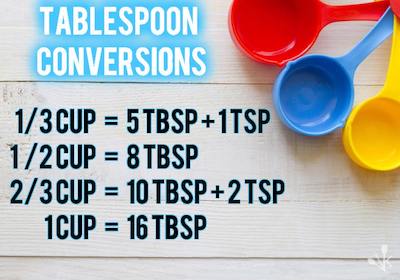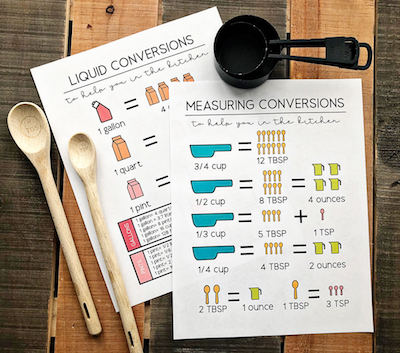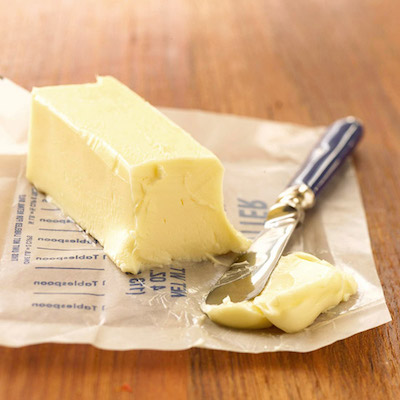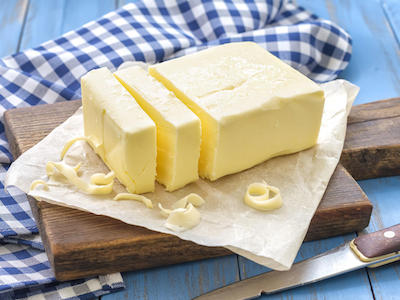1/3 Cup = 5.33 Tablespoons
If you are someone who likes to cook but who especially likes to bake, then you are probably wondering about how to make all the conversions between different units of measurement easier.
We have got to say that you are right when you think that there are just too many different units of measurement. And this not to mention that you need to be careful to see if you need to use the United States Customary System or the Imperial or British Measurement System.
The reality is that between cups, tablespoons, ounces, grams, milliliters, among so many others, these can all be a bit confusing. So, we decided to focus our attention on tablespoons and cups only today.
The truth is that most of the recipes that you usually follow tend to include either tablespoons or cups or even both in some occasions. In case you are wondering the reason, sometimes it is easier to measure one specific ingredient using one measurement utensil over the other one. However, when you need to do this, you want to ensure that you do it the right way. And the only way is to know how many tablespoons in 1/3 cup. While there are other measurement conversions that you may need to do, you probably already noticed that using 1/3 cup is very common.
In case you usually follow recipes from the United Kingdom, that it is highly unlikely that you find measuring cups in there. And the reason is simple. While the United States and Canada continue to use cups, the same can’t b said about the United Kingdom. In fact, they haven’t been using cups for measuring ingredients since the 1960s. Nevertheless, you may still need to convert cups into tablespoons if you are using an older recipe or even a newer but where the cooker or baker prefers to use measuring cups.
Before we explain to you exactly how many tablespoons in 1/3 cup there are, we believe that it is important that you understand a bit more about each one of the units of measurement that we are covering today – cups and tablespoons. We believe that the better you understand, the easier it will be for you to make conversions. So, let’s get started.
What Is A Cup?

A cup is a unit of volume that is included not only in the United States customary system but also in the Imperial or British Measurement System.
One US cup is equal not only to 16 US tablespoons but it is also equivalent to 48 U.S. customary teaspoons, 8 U.S. customary fluid ounces, and 1/16 U.S. customary gallons. Notice that 1 cup is exactly 236.6 milliliters, but in nutrition labeling, one cup is equal to 240 milliliters.
The cup is a unit of measurement that is currently used to measure both bulk foods and liquids. The truth is that using cups can be a bit confusing since you may have the tendency to use a drinking cup. However, as you already know, these do have different sizes and, most of the time, they are not a good representation of this unit. Therefore, when you need to use a cup to measure an ingredient, you should stick to standardized cups.
What Is A Tablespoon?
As we already mentioned, a tablespoon is also a unit of volume that you can use to measure both dry and liquid ingredients.
One of the things that you need to know about tablespoons is that they are not all the same everywhere and not even within the same country. But we will look into that further below. For now, what is important to keep in mind is that the United States customary tablespoon is equal to approximately 14.8 l, a metric tablespoon is exactly equal to 15 ml, and an Australian tablespoon is equal to 20 ml. In nutrition labeling in both the United States and the United Kingdom, a tablespoon is defined as 15 ml.
One tablespoon is exactly the same as 3 teaspoons as well as it is exactly the same as half fluid ounce.
The tablespoon is currently used in three main countries: the United States, the United Kingdom, and in Australia.
How Many Tablespoons In A Cup – Using Our Converter
If you take a look at the top of this page, you will see that we have created a converter for you so that you can easily and quickly determine how many tablespoons in 1/3 cup.
Notice that this converter was created thinking about the US tablespoon as well as the US cup.
In order to use our converter and determine how many tablespoons in 1/3 cup, you will need to fill out the first field with the number of 1/3 cups that you want to convert into tablespoons. As soon as you do this, our converter will immediately tell you how many tablespoons there are in the specific number of 1/3 cups that you wrote.

Here’s a quick example. Let’s imagine that you are baking a cake and that the recipe you are following asks you to add 3 X 1/3cups of sugar to the mixture. So, if you prefer to use tablespoons, all you need to do is to add 3 to the Cups field and then check the result in tablespoons in the next field of our converter.
As you can see, there are 16 tablespoons in 3 X 1/3 cup. If you think about it, it makes perfect sense. After all, in case you don’t know:
1 US cup = 16 US tablespoons.
Since you wanted to add 3 1/3 cups, this is the same as saying that you would need to use:
1/3 + 1/3 +1/3
In case you don’t know or don’t remember fractions rules for addition, then you just need to keep in mind that when you have a common denominator (as we do in this case), you just need to sum the numerators and maintain the denominator.
So, you would get:
1/3 + 1/3 +1/3 = (1 + 1 + 1) / 3 = 3/3 = 1 cup
But what about if you have the number of tablespoons and you want to determine the number of /3 cups?
Well, in that case, you can also use our converter. Let’s imagine that your recipe tells you to add 80 tablespoons of chocolate. So, you would now need to add the 80 to the Tablespoons field this time (the second one). As soon as you do this, you will see that there are 3.75 1/3 cups in 80 tablespoons. So, you could simply add 3.75 1/3 cups of chocolate to your recipe instead of adding 80 tablespoons.
How Many Tablespoons Are In 1/3 Cup – By Hand
When you are trying to determine how many tablespoons are in 1/3 cup, it is always easier and faster to have a converter like the one that is located at the top of this page near you. However, sometimes, this may not be possible. So, you need to make sure that you can easily convert cups to tablespoons as well as tablespoons to cups on your own. So, let’s see how you can easily do it on your own and without using our converter.
Let’s say that you are preparing a recipe and that you need to add 2 X 1/3 cups of flour. So, considering that:
1/3 Cup = 5.33 Tablespoons
2 X 1/3 cups of flour = 2 X 5.33 Tablespoons
2 X 1/3 cups of flour = 10.66666 Tablespoons
What about if you need to add 12 tablespoons of syrup to a recipe?
Well, in this case, you will need to make the opposite conversion. So, you will need to consider that:
1/3 Cup = 5.33 Tablespoons
is the same thing than stating that:
1 tablespoon (US) = 0.1875 1/3 cup (US)
Considering that you are now looking to convert 12 tablespoons into cups:
12 tablespoons (US) = 12 X 0.1875 1/3 cup (US)
12 tablespoons (US) = 2.25 1/3 cups (US)
How Many Tablespoons Are In 1/3 Cup – Quick Conversion Table
| Cups | Tablespoons and Teaspoons |
| 1/16 cup | 1 tablespoon |
| 1/8 cup | 2 tablespoons |
| 1/6 cup | 2 tablespoons plus 2 teaspoons |
| 1/4 cup | 4 tablespoons |
| 1/3 cup | 5 tablespoons plus 1 teaspoon |
| 3/8 cup | 6 tablespoons |
| 1/2 cup | 8 tablespoons |
| 2/3 cup | 10 tablespoons plus 2 teaspoons |
| 3/4 cup | 12 tablespoons |
| 1 cup | 16 tablespoons |
How Many Tablespoons 1/3 Cup Butter

As you know, no matter if you are cooking or baking, one of the most frequently used ingredients is butter. However, butter is measured and weighted in a different way depending on you are located in the world. And this can be a bit confusing when you are trying to determine how many tablespoons 1/3 cup butter.
So, we decided to show you how you can easily convert butter to the unit of measurement that you prefer or that you need to use.
One of the things that tend to intrigue a lot of people is that most countries outside the United States and Canada weigh butter using scales. So, as you can easily see, they use the metric system (meaning that they use grams). And since neither Americans or Canadians are very used to using these measurement units, it can get confusing.
If you gather a bunch of American recipes that have butter as an ingredient, it will be easy for you to notice that they vary a lot in what concerns measuring butter. After all, you will be able to see some American recipes that use sticks, others use cups, others use teaspoons, and still others prefer to use tablespoons.
Here are the main differences regarding butter around the world:
#1: The Percentage Of Fat:
The truth is that butter is different across the countries in terms of fat that it includes. For example, in the United States, the butter needs to have at least 80% fat content. However, if you take a look at French butter, it may surprise you that it needs to contain a minimum of 82% fat.
Notice that the higher the fat content in butter, the less water it will contain. This means that your pastries will be flakier. Besides, more fat also means faster melt, a softer texture, and a deeper yellow color.
#2: The Taste:
One of the things that you may not know is that European butter is known for its rich taste. And this is just the direct consequence of the higher butterfat content. So, when you are baking, you should always prefer to use European butter if you have the chance to do it.
Measuring And Weighing Butter
The truth is that there are certain aspects that you need to consider as well as to keep in mind when it’s time to measure and weigh butter. So, here are a couple of tips that will help you out in this process:
#1: Memorize Only A Conversion Ratio:
When you tend to use butter quite often on your recipes, the last thing that you want or need is to keep getting back here to calculate the amount of butter that you need to measure and weigh. Therefore, a better option and solution is to simply memorize the conversion ratio. For example, you may keep in your mind that 1 stick of butter is equal to 1/2 cup of butter. So, no matter if the recipe asks for 5 sticks of butter or just 2, you can easily convert these. After all, it is easier to see that if:
1 stick of butter = 1/2 cup of butter
Then:
5 sticks of butter = 5/2 cups of butter = 2.5 cups of butter
2 sticks of butter = 1 cup of butter.
#2: Get The Habit Of Weighing Butter:

One of the things that you should really consider doing is to weigh the butter that you need all the time. The truth is that before you use the guide on the package or add to your measuring cup, just use a scale to get its accurate weight.
American Sticks Of Butter
There is no question that sticks of butter can be pretty handy on some occasions. Here are some of the things that you need to keep in mind about them:
- When you are following an American recipe, it is normal to see that most of them will call for butter in sticks. Nevertheless, you can measure butter in many different ways and these include pounds, ounces, cups, and tablespoons.
- If you are in the United States, then that’s not a surprise to know that butter is only available in half a pound or 1 pound packages. These tend to be split into wrapped sticks. Each one of these sticks weighs 110 grams or 1/4 pound each, which is also equal to 1/2 cup.
- If you take a closer look at the wrapping on each stick, then you will see that it also has some marks showing tablespoon measurements. Just so that you know, there are eight tablespoons in a stick.
Learn more about measuring with cups.
Tips When Baking With Butter
- Whenever you need yo work with butter that has been defrosted, then you need to make sure that you don’t defrost it in a microwave, The main reason is that if you do it, you will simply destroy the emulsion. So, in these cases, it is always better to cut it into chunks and just leave it out until it’s still cold but workable.
- In case you are wondering about when you can know if the butter is at room temperature, look no further. We have the answer for you. The truth is that you can tell if it is at the right temperature whenever you have it wrapped and the butter leaves a bit of residue on the wrapping. Another way to know that it is at the right temperature is that when you have a cube that simply blends easily without cracking or breaking.
- As a rule of thumb, every time your recipe calls for creaming butter, you just need to let your mixer whip the butter for 3 minutes.
- When you need to mix butter, you shouldn’t do it at a high speed. The truth is that this way, it will heat and lose its emulsion. So, during the creaming process, you need to ensure that you keep your mixer at a relatively low speed.
